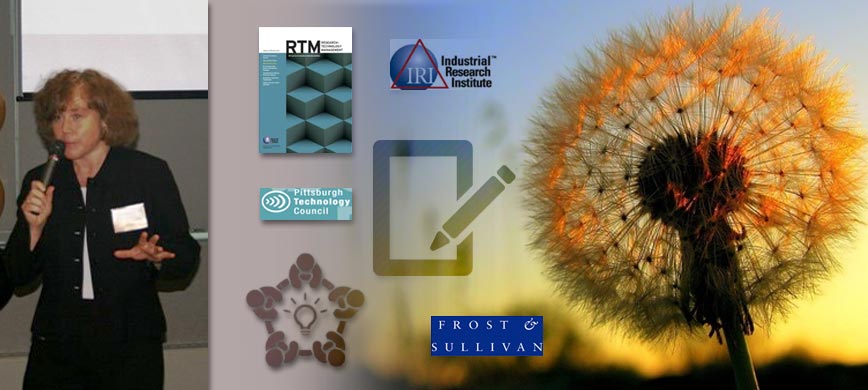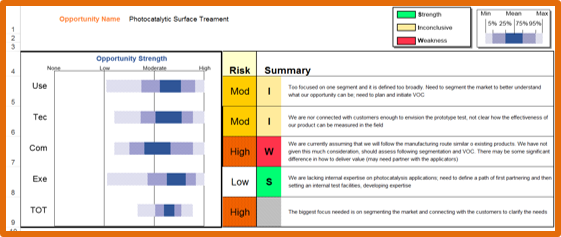

RECENTLY PUBLISHED
From Emerging Technology to Business Opportunity, Presented by Dr. Irene Spitsberg of InnoVentures and Dr. Anne Berthereau, VP of Composite Business Solutions and Emerging Technology at Owens Corning, at the Industrial Research Institute’s 2017 IRI Annual Meeting
Read moreTwo-part webinar hosted by PDMA : Applying Agile Strategies to Outside-the-Core Innovation and How to Actually Make It work, presented by Irene Spitsberg
Part 1:
Part 2:
Read more
“Capitalizing on Emerging technologies – a Path to Creating Opportunities in New Markets”, Irene Spitsberg, Michael J. Verti, Sudhir Brahmandam, and George W. Coulston
Read more“Technology Landscape Mapping – At the Heart of Open Innovation”, Irene Spitsberg, Sudhir Brahmandam, Michael J. Verti, and George W. Coulston
Read more
Our uniquely designed tools accelerate your ideas by driving alignment and focus.
ACCEL – Opportunity Builder Tool facilitates in-depth assessment of key uncertainties and risks of a given opportunity.

The project team answers 19 detailed open-ended questions across the Market, Technology, Business, and Organization domains.
Read more
We build new innovation processes and adapt the industry leading practices to the business challenges.
New Growth
Scenario Planning
Scenario planning is a process that was originally developed within Shell is now widely used in industry to prepare for what lies ahead. Our framework is an adaptation of this process for technology planning. It pinpoints the areas of both disruption and opportunities and informs strategic decisions and resource planning.
Agile Innovation Systems™
Innovation Systems (AIS). is a blueprint for execution to find new growth opportunities, build and commercialize new growth platforms, and generate new growth strategies through Open Innovation.
Opportunity Creation Formula Framework
You can start identifying opportunities from either market or technology views. In the end, it is about pin-pointing challenges can be addressed by the company’s own capabilities, as well as identifying and developing the critical set of the capabilities required for delivering true value.
Technology Landscape™
By expanding the focus of the scouting effort from well-defined core needs to a systematic understanding of the related technology space for strategic purposes, the Technology Landscape TM mapping process identifies strategic technologies that can open new growth opportunities for the company.
Core and Adjacency
Technology Commercialization Framework
(a stage-gate process for Technology development)
Creating new product platforms sometimes requires new technology. The success of technology development can be enhanced by using a systematic and focused development process.

The Innovator’s Solution, C.M. Christensen and M. E. Raynor, Harvard Business School Press, 2009
Open Innovation: Researching a New Paradigm, H. Chesbrough, W. Vanhaverbeke, J. West, J., Oxford, UK: Oxford University Press, 2006.
Grabbing Lightning: Building a Capability for Breakthrough Innovation, G.C. O’Connor, A.S. Paulson, and R. Leifer, NJ. John Wiley & Sons, Inc., 2008
The Innovator’s Guide to Growth, S.D. Anthony, M. W. Johnson, J. V.Sinfield, E. J.Altman, 2008
The First Mile, S. D. Anthony, Harvard Business Review Press, 2014
Business Model Generation, A. Osterwalder, Y. Pigneur, John Wiley &Sons, 2010
Ten Types of Innovation, L. Keeley, R.Pikkel, B. Quinn, H.Walters, John Wiley & Sons, 2013
Lean Start-up, Eric Reis, Crown Business, 2011
Jugaad Innovation, N. Radjou, J.Prabhu, S. Ahnuja, Josseryy-Ross, 2012

“Red Ocean Traps”
by W. Chan Kim Renée Mauborgne, Harvard Business Review, March 2015 issue
Authors of the book Blue Ocean Strategy, share their view on “six red ocean traps … that effectively anchor managers in red oceans—crowded market spaces where companies engage in bloody competition for market share—and prevent them from entering blue oceans, previously unknown and uncontested market spaces with ample potential. The first two traps stem from assumptions about marketing, in particular an emphasis on customer orientation and niches; the next two from economic lessons on technology innovation and creative destruction; and the final two from principles of competitive strategy that regard differentiation and low cost as mutually exclusive choices”.

 Technology landscape maps can help organizations build awareness of strategic technologies and identify opportunities at the intersection of emerging technologies and customer needs.
Technology landscape maps can help organizations build awareness of strategic technologies and identify opportunities at the intersection of emerging technologies and customer needs.